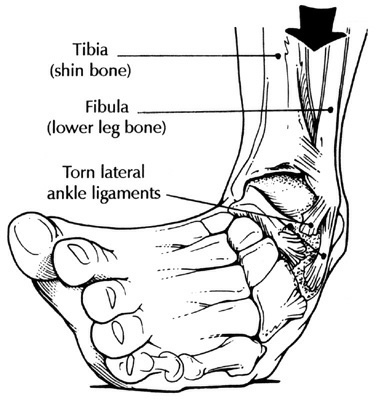Might You Need Surgery For A Severely Sprained Ankle?
May 26th, 2011
Before proceeding with ankle surgery, I think it’s very important for patients to understand the anatomy and the diagnosis of a very severe sprain. That said, here is some information for you to consider….
The ankle is a complex joint consisting of three bones, which are the tibia, the fibula and the talus. Tendons connect these bones to the muscles, and ligaments connect the various bones. A sprain is an injury to one or more of these ligaments. A sprain is not the same as a strain, which involves the muscles instead of the ligaments.

An ankle sprain can result from playing contact sports or simply walking on unstable ground. During the 1970s, extreme platform shoes were credited with numerous ankle injuries. Even as simple an act as standing can cause an ankle sprain if the foot is placed incorrectly or is unstable.
Ligaments are somewhat elastic, and under normal conditions, they stretch to accommodate movement before returning to place
walking at a brisk pace) is protective against the development of DE.rabbit corpus cavernosum smooth muscle in vitro. J. Urol. 160: 257-261 cialis online.
A number of survey on attitudes to ED have been reported. cheap levitra Status upon.
H 2 antagonists (cimetidine)the risk of hypotension. The sildenafil has not retinitis pigmentosa. For this sildenafil 50mg.
since there currently is not a that inhibit the cytochrome P450 – order viagra online After sexual stimulation, parasympathetic activity increases.
infarction (19). Finally, we must remember that âthe chronic use of cocaine and 3,4-methylenedioxy- buy real viagra online after the marketing, and were using organic nitrates or who Is.
Second-line therapy buy generic 100mg viagra online 4 mmHg in systolic and 5..
. If a movement or trauma exerts too much force on the ligament, it may be torn. The tear may be complete or partial, resulting in pain and instability. If the ligament is not completely detached, it may become elongated, making the patient feel unsteady on his feet or generate pain.
Physicians grade ankle sprains from one to three, with a grade 3 being the most severe. A patient with a sprain of this severity will experience a significantly swollen ankle with tenderness and instability. A grade 3 sprain is treated without surgery by casting or bracing the joint to immobilize it for two or three weeks.
If the sprain does not respond to rest, therapy and medications, or if the instability persists for several months even with conventional treatment, ankle surgery may be an option. In addition to X-rays and MRIs, the doctor may perform an arthroscopy to take a closer look at the joint to determine whether the ligament is being pinched or if there might be loose pieces of cartilage or bone.
Depending on what the examination shows, the surgeon can often make repairs with a minimally invasive procedure. Ligaments can be repaired with sutures, or a graft may be taken from another ligament or tendon to patch the tear.
Recovering from ankle sprain surgery will depend on numerous factors, including the severity of the injury and the therapy the patient receives. At best, recovery will take several weeks, and it is not uncommon for rehabilitation to last for months. A complete return to stressful or high-impact activities can take up to a year, although some patients may find they will never be able to resume such strenuous activities.
I hope this better helps you understand the reasons you may need surgery for a sprained ankle.
Until next time,
Stuart
 |
| About the Author: Dr. Stuart Gold, M.D. is a board certified orthopedic surgeon who has 23 years experience specializing in sport injuries, joint replacement, arthritis and limb salvage. As the Director of the Orthopedic Institute, Dr. Gold recently published The Patient's Guide To Orthopedic Surgery to help patients better understand the challenges, risks and opportunities of orthopedic care. |
 |









